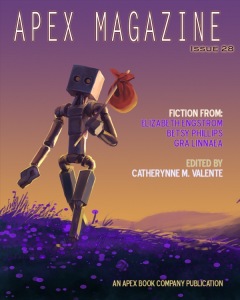 Apex #28, September 2011
Apex #28, September 2011
“Namasté Prime” by Grá Linnaea
“Frank” by Betsy Phillips
Reviewed by Colleen Chen
Grá Linnaea’s “Namasté Prime” stars Tether, who has returned to his home in New Ishvara after being offworld for six months. He has accepted a job to find a man named Dirvis Ejiri, a reincarnation manager at the cognitive backup center. In this future, reincarnation is a simple process—clones are infused with personality backups from a database, and an additional “holographic being” created from information from the deceased is inserted into the clone.
Tether discovers that he’s working for Billy-Billy, a born-again mobster-type, who picks him up and gives him the additional job of infiltrating Namasté, a group of hackers who hack personality backups. People can experience mined dreams from other personalities through an industry that sells merged copies of people.
Through his investigations, Tether gets “digitized” at a Hare Krishna temple. The digital copy of him learns that Namasté is the result of hundreds of personalities—profiles and backup signals—brought together to form a single unified mind, a general consciousness that could be equated to “heaven.” Billy-Billy wants to destroy the Namasté movement as a threat to his concept of God. Tether has to decide whether to help the movement, or to continue with his job for Billy-Billy and all its attendant riches.
This story would make an excellent dystopian SF action movie. It wasn’t a comfortable read for me; a world I really would not like to live in is painted that is as visceral as a nightmare. Incessant drug use is normal here, a mechanism for coping and increased efficiency, and the wi-fi network is pervasive, infiltrating everything—including the subconscious, potentially becoming the medium for divine connection for all. I found Tether empty and unlikable, reflective of his society and his vocation. Despite my discomfort the story is very well done, thought-provoking, and rich in images and intricate futuristic vocabulary, and it takes current trends of spirituality and computer networks to a conclusion that seems entirely possible.
“Frank,” by Betsy Phillips, is an interesting foil for the first story, as it has just as much depth but its presentation is entirely different. The beginning, in which a man named Frank appears to be teaching a woman how to drive a truck, seems simple and normal. With a sentence here and there, it gets progressively weirder, with dreams blending seamlessly into reality and a zombie story that might just be a story of drugs and deception.
We learn that this woman is one of many young women captured by someone called “the doc,” who puts them in cages, then supposedly kills them, buries them, and brings them back to life as servants with no names, only numbers. Frank guards these women, finds them if they try to escape, and kills them if they “aren’t right.” This young woman turns out to be different, and through interacting with her, Frank begins to recall memories from the time before the doc killed him.
I loved this piece. It’s rare that I read something that doesn’t remind me of anything else I’ve ever read, and this story achieves that—it is totally unique. It’s part horror but mostly love story, heartwarming and sad and tense all at the same time. I loved the heroine for her courage and intelligence. I’m usually a happy ending junkie, but even without knowing that the characters will be all right I thought the ending was perfect—the love story aspect is complete enough in itself to satisfy my happy-craving.